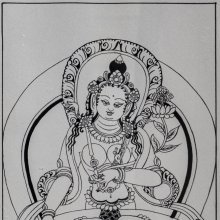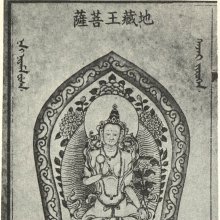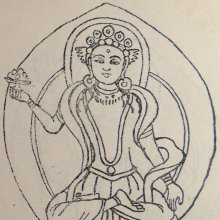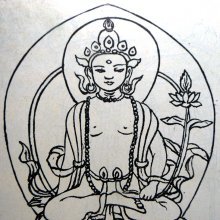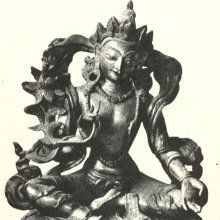Kshitigarbha, Kṣitigarbha, Ksitigarbha: 14 definitions
Introduction:
Kshitigarbha means something in Buddhism, Pali, Hinduism, Sanskrit. If you want to know the exact meaning, history, etymology or English translation of this term then check out the descriptions on this page. Add your comment or reference to a book if you want to contribute to this summary article.
The Sanskrit term Kṣitigarbha can be transliterated into English as Ksitigarbha or Kshitigarbha, using the IAST transliteration scheme (?).
Images (photo gallery)
(+5 more images available)
In Buddhism
Mahayana (major branch of Buddhism)
Source: Burmese Art: Bodhisattva Ksitigarbha - Great Vow to Help all beingsBodhisattva Ksitigarbha is one of the four principal boddhisattva in Mahayana Buddhism. Bodhisattva Ksitigarbha took a great vow to guide all living beings from the hell and denied to achieve Buddhahood until all hells are emptied. The term “Ksitigarbha” refers to meaning “Earth Treasury”, “Earth Store”, “Earth Matrix”, or “Earth Womb”. Bodhisattva Ksitigarbha was foremost as Great Vow to help and to deliver all beings. Bodhisattva Ksitigarbha was depicted as Buddhist monk with a shaved head wearing simple robes wielding a staff.
“If I do not go to the hell to help the suffering beings there, who else will go? ... if the hells are not empty I will not become a Buddha. Only when all living beings have been saved, will I attain Bodhi.” – Ksitigarbha Greatest Compassionate Vow

Mahayana (महायान, mahāyāna) is a major branch of Buddhism focusing on the path of a Bodhisattva (spiritual aspirants/ enlightened beings). Extant literature is vast and primarely composed in the Sanskrit language. There are many sūtras of which some of the earliest are the various Prajñāpāramitā sūtras.
Tibetan Buddhism (Vajrayana or tantric Buddhism)
Source: Wisdom Library: Tibetan BuddhismKṣitigarbha (क्षितिगर्भ) is the name of a Bodhisattva mentioned as attending the teachings in the 6th century Mañjuśrīmūlakalpa: one of the largest Kriyā Tantras devoted to Mañjuśrī (the Bodhisattva of wisdom) representing an encyclopedia of knowledge primarily concerned with ritualistic elements in Buddhism. The teachings in this text originate from Mañjuśrī and were taught to and by Buddha Śākyamuni in the presence of a large audience (including Kṣitigarbha).
Source: archive.org: The Indian Buddhist Iconography1) Kṣitigarbha (क्षितिगर्भ) (“matrix of the earth”) is the name of a Bodhisattva commonly depicted in Buddhist Iconography, and mentioned in the 11th-century Niṣpannayogāvalī of Mahāpaṇḍita Abhayākara.—His color is yellow or green; his symbol is the kalpa-tree or jar.—The third Bodhisattva Kṣitigarbha is rarely represented. He is described twice in the Niṣpannayogāvalī. In one, he is identical with his sire Vairocana with the Cakra symbol.
Kṣitigarbha is also described in the Niṣpannayogāvalī as follows.—
“Kṣitigarbha is yellow in colour, shows the earth-touching mudrā in the right hand, and a lotus with the wish-giving tree (kalpavṛkṣa) in the left”
Kṣitigarbha is also described in the Sādhanamālā (under Lokanātha-sādhana):—
“Kṣitigarbha is of green colour, and shows in his two hands the jar and the Abhaya-mudrā”.
2) Kṣitigarbha (क्षितिगर्भ) or Kṣitigarbhalokeśvara refers to number 50 of the 108 forms of Avalokiteśvara found in the Machhandar Vahal (Kathmanu, Nepal). [Machhandar or Machandar is another name for for Matsyendra.].
Accordingly,—
“Kṣitigarbha also is [Avalokita Lokeśvara] except that here the god carries a tray of gems in his right hand and displays the Varada mudrā in his left.—Avalokita Lokeśvara also is one-faced and two-armed and sits in the same attitude on a lotus. He wields the sword in his right hand and holds the stem of a lotus against the chest with his left”.
The names of the 108 deities [viz., Kṣitigarbha] possbily originate from a Tantra included in the Kagyur which is named “the 108 names of Avalokiteshvara”, however it is not yet certain that this is the source for the Nepali descriptions.Source: Wisdomlib Libary: Vajrayogini
Kṣitigarbha (क्षितिगर्भ) is the name of a deity to be contemplated upon by a practicioner purifying his correspondences (viśuddhi), according to the 12th-century Abhisamayamañjarī. Kṣitigarbha is alternatively known by the name Mohavajra because he destroys ignorance (moha). The contemplation is prescribed as a preliminary ritual for a yogin wishing to establish, or reestablish the union with a deity.
Kṣitigarbha is associated with the eyes and the color white. He is to be visualised as holding an attribute in his right hand and a bell in his left. The deities of the sense organs and fields are the esoteric equivalents of the deities associated with the skandhas.
Source: academia.edu: The Structure and Meanings of the Heruka MaṇḍalaKṣitigarbha (क्षितिगर्भ) is the name of a Vīra (hero) who, together with the Ḍākinī named Kṣitigarbhī forms one of the 36 pairs situated in the Hṛdayacakra, according to the 10th century Ḍākārṇava chapter 15. Accordingly, the hṛdayacakra refers to one of the four divisions of the sahaja-puṭa (‘innate layer’), situated within the padma (lotus) in the middle of the Herukamaṇḍala. The 36 pairs of Ḍākinīs and Vīras [viz., Kṣitigarbha] are reddish yellow in color; they each have one face and four arms; they hold a skull bowl, a skull staff, a small drum, and a knife.
Source: OSU Press: Cakrasamvara SamadhiKṣitigarbha (क्षितिगर्भ) is the name of a deity [i.e., oṃ kṣitigarbhāya svāhā], according to the Guru Mandala Worship (maṇḍalārcana) ritual often performed in combination with the Cakrasaṃvara Samādhi, which refers to the primary pūjā and sādhanā practice of Newah Mahāyāna-Vajrayāna Buddhists in Nepal.—

Tibetan Buddhism includes schools such as Nyingma, Kadampa, Kagyu and Gelug. Their primary canon of literature is divided in two broad categories: The Kangyur, which consists of Buddha’s words, and the Tengyur, which includes commentaries from various sources. Esotericism and tantra techniques (vajrayāna) are collected indepently.
General definition (in Buddhism)
Source: Wisdom Library: BuddhismKsitigarbha (kṣitigarbha) is a bodhisattva primarily revered in East Asian Buddhism, usually depicted as a Buddhist monk in the Orient. The name may be translated as "Earth Treasury", "Earth Store", "Earth Matrix", or "Earth Womb". Ksitigarbha is known for his vow to take responsibility for the instruction of all beings in the six worlds between the death of Gautama (Sakyamuni) Buddha and the rise of Maitreya Buddha, as well as his vow not to achieve Buddhahood until all hells are emptied.
Ksitigarbha is one of the four principal bodhisattvas in East Asian Mahayana Buddhism.
Usually depicted as a monk with a halo around his shaved head, he carries a staff to force open the gates of hell and a wish-fulfilling jewel to light up the darkness.
Source: Wisdom Library: Dharma-samgrahaKṣitigarbha (क्षितिगर्भ) refers to the seventh of the “eight Bodhisattvas” (aṣṭabodhisattva) as defined in the Dharma-saṃgraha (section 12). The Dharma-samgraha (Dharmasangraha) is an extensive glossary of Buddhist technical terms in Sanskrit (e.g., aṣṭa-bodhisattva and Kṣitigarbha). The work is attributed to Nagarguna who lived around the 2nd century A.D.
Source: Buddhist Door: GlossaryEarth Store Bodhisattva. He is now the guardian of the earth. Depicted with the alarum staff with its six rings, he is accredited with power over the hells and is devoted to the saving of all creatures between the Nirvana of Shakyamuni and the advent of Maitreya. He vows that while the hell is not empty, he will not attain Buddhahood. As his vow is the greatest, he is also known as The Great Vow Bodhisattva.Source: The Art of Asia: Who is Who in HeavenKsitigarbha (Chinese: Ti tsang; Japanese: Jizo) is worshipped as a savior to those condemned to the torments of hell. Since the 10th century, he as been portrayed as a young, itinerant monk who carries a pilgrims staff and a wish granting jewel. On a popular level, he is also believed to assist the wayward souls of deceased children.Languages of India and abroad
Sanskrit dictionary
Source: Cologne Digital Sanskrit Dictionaries: Edgerton Buddhist Hybrid Sanskrit DictionaryKṣitigarbha (क्षितिगर्भ).—name of a well-known Bodhisattva: Mahāvyutpatti 652; Daśabhūmikasūtra 2.7; Sādhanamālā 49.12; (Ārya-)Mañjuśrīmūlakalpa 406.1; 425.19; one of a list of eight, Dharmasaṃgraha 12; (Ārya-)Mañjuśrīmūlakalpa 62.13; one of sixteen, (Ārya-)Mañjuśrīmūlakalpa 40.13. Cf. next.
Source: Cologne Digital Sanskrit Dictionaries: Monier-Williams Sanskrit-English Dictionary1) Kṣitigarbha (क्षितिगर्भ):—[=kṣiti-garbha] [from kṣiti > kṣi] m. Name of a Bodhi-sattva, [Buddhist literature]
2) Kṣitīgarbha (क्षितीगर्भ):—[=kṣitī-garbha] [from kṣiti > kṣi] for ti-g q.v.
[Sanskrit to German]
Sanskrit, also spelled संस्कृतम् (saṃskṛtam), is an ancient language of India commonly seen as the grandmother of the Indo-European language family (even English!). Closely allied with Prakrit and Pali, Sanskrit is more exhaustive in both grammar and terms and has the most extensive collection of literature in the world, greatly surpassing its sister-languages Greek and Latin.
See also (Relevant definitions)
Partial matches: Garbha, Kshiti.
Starts with: Kshitigarbhalokeshvara, Kshitigarbhasutra.
Ends with: Dashakshitigarbha.
Full-text: Dashakshitigarbha, Khagarbha, Four Great Bodhisattvas, Mohavajra, Ashtabodhisattva, Eight Bodhisattvas, Padmapani, Kshitigarbhalokeshvara, Vishkambhin, Udyata, Maitreyatmaka, Parahitodyata, Parahita, Bodhisattva, Yakshadhipa, Mahasattva, Kshitigarbhi, Cintamani, Hridayacakra, Lokanatha.
Relevant text
Search found 17 books and stories containing Kshitigarbha, Kṣitigarbha, Ksitigarbha, Kshiti-garbha, Kṣiti-garbha, Ksiti-garbha, Kṣitīgarbha, Kṣitī-garbha; (plurals include: Kshitigarbhas, Kṣitigarbhas, Ksitigarbhas, garbhas, Kṣitīgarbhas). You can also click to the full overview containing English textual excerpts. Below are direct links for the most relevant articles:
Sutra of Ksitigarbha Bodhisattva's Fundamental Vows
Chapter 6 - Shakyamuni Buddha Praising Ksitigarbha Bodhisattva
Chapter 12 - The Benefit through Sight and Hearing
Chapter 4 - Evil Actions and Retributions of Human Beings of the Samsara World
Ksitigarbha Bodhisattva fundamental vow sutra (by Johnny Yu)
Chapter 6 - Tathagata's Praises
Chapter 10 - Comparison of Merits Derived from Giving Alms
Sūtra of the Great Vow of Kṣitigarbha Bodhisattva
The Indian Buddhist Iconography (by Benoytosh Bhattachacharyya)
Figure 51 - Bodhisattva Kṣitigarbha
108 forms of Avalokiteśvara (50): Kṣitigarbha Lokeśvara
The gods of northern Buddhism (by Alice Getty)
The Great Chariot (by Longchenpa)
Part 4a.3 - Meditating on the deities < [B. The explanation of meditation practice, together with its action of ripening and freeing]
Part 4a.4 - The great mandala of the environment and inhabitants < [B. The explanation of meditation practice]
Part 2b.2 - The two individual explanations of shamatha and vipashyana < [B. The teaching of the three factors of immovable samadhis]
Related products
